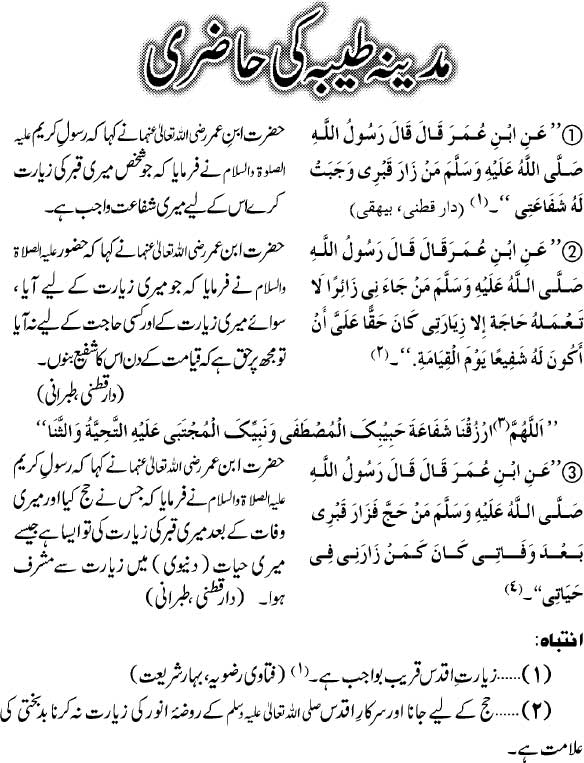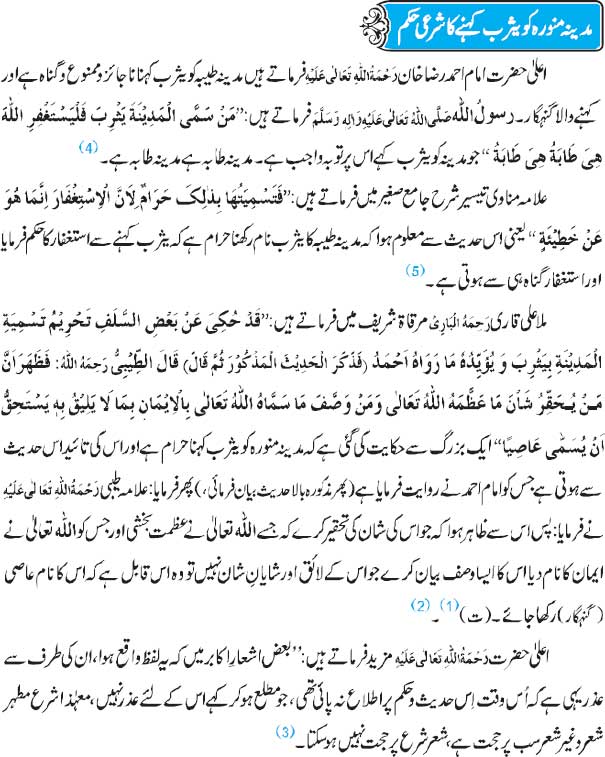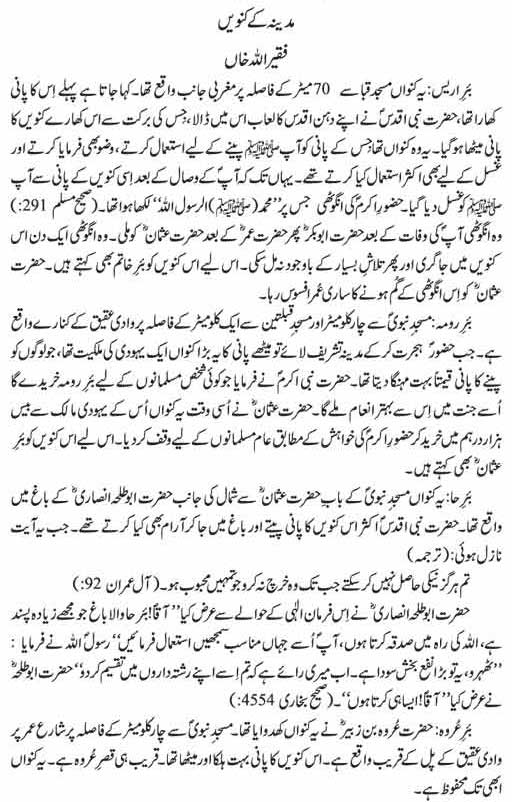
Husn-e-Khatima: Madina Tayyaba Mein Qayam Aur Wahan Moat Ka Pana
TAG: Madina
Madina Munawara Kay Fazail

Madina Munawara Kay Fazail
Jannat-ul-Baqi
The most pious and spiritual graveyard of the world is called, “Jannat-ul-Baqqi” where several companions (RA), wives daughters, and other family members of Prophet Muhammad sallalla ho allihi wasallam are lying to rest. In the time of Prophet sallalla ho allihi wasallam live hood, this graveyard was thought to be outside Madina City but after the vast extension, it has now come just adjacent to Masjid-e-Nabvi. If you come out from Masjid-e-Nabvi, through Baqqi Gate, or Jibrael (AH) Gate you will see a few yards ahead a boundary wall at a little height. This is JANNAT -UL -BAQQI’S wall. Stairs are made to reach the height.
Men can visit this graveyard going inside but ladies are not allowed even to go up near the wall of the graveyard. Ladies must present their Salaam outside Baqqi. Baqqi is a very clean and tidy graveyard. No bush or tree is there. All the graves are made of mud. No concrete constructions over the graves are made. Pavement and passages are made for easy walking but there is no sign over the graves have been given to know the name of the buried personality. Some guides (Moaleems) tell about graves. A squared boundary of half a foot high has been built around all prominent graves.
People must visit this graveyard with great respect as many great personalities are lying to rest here.
When you enter inside “Baqi”, a few feet ahead, slightly on your right you will see the graves of the daughters of prophet sallalla ho allihi wasalam .Three daughters named Syeda Umm-e-Kulsoom, Syeda Ruqiya, and Syeda Zainab Raddi Allah ho ta’ala Anhuma are buried here. A few steps ahead you may find nine graves of the wives of the Prophet (S. A. W.) including Syeda Ayesha Radi Allah ho talla anha.These graves are combined. After entering in Baqqi cemetery, if you take a left turn and come to the corner near the boundary wall you will find the grave of the closest aunt of Prophet (S. A. W.) Syeda Safia (RA). If you walk straight you will find the grave of Prophet’s (S.A.W) little son Syedna Ibrahim (RA). This is a smaller grave in size and pilgrims may recognize it easily.
If you take a right turn just entering to jannat-ul-baqi you will find the grave of prophet sallalla ho allihi wasallams’ grandson Syedna Hasan (RA). He is buried along with other family members of the prophet sallallaho allihi wasallam. The graves of Syedna Abbas (uncle of the prophet) and other imams like Syedna Baqar R.A and Jafar Sadiq R.A are also situated beside the grave of Syedna Hasan radi Allah ho talla anho. The beloved daughter of the prophet Muhammad sallalla ho allihi wasalam and the lady of Janna (Heaven) “Fatima -ul-Zuhra (RA)” is also lying rest just adjacent to these graves. In the last, almost crossing whole the graveyard, you may find the grave of the most respectable personality in this graveyard, “Syedna Usman (RA) “. Slightly on the left, a little before the grave of Syedna Usman Raddi Allah ho talla Anho, there is a grave of ” Syeda Haleema (RA)” who fed Prophet (S. A. W.), when he was an infant.
Few Important And Holy Graves In Jannat-Ul-Baqi
Grave of Hazrat Ibrahim R.A. (Son of Prophet Mohammed P.B.U.H.) He was the beloved son of prophet sallalla ho allihi wasallam. He passed away in his childhood. His mother was um-ul-momeeneen Syeda Maria Qutbia who herself lying to rest in Jannat-ul-Baqqi
Grave of Syedna Osman R.A. This is the holy grave of the 3rd caliph and beloved companion of Prophet Muhammad sallallaho allihi wasallam. this grave is known as the most sacred grave of Jannat-ul-Baqqi.
Grave of Hazrat Haleema R.A. Syeda Haleema Sadia got the honor to feed her milk to beloved prophet Hazrat Muhammad sallallaho allihi wasallam when he sallallalho allihi wasallam was handed over to her. According to Arabic custom an infant just after his birth had been handed over to a nurse or governess for better care in the open and healthy atmosphere outside the city. Syeda Haleema Sadia belonged to bnnu saad(saad family)
Grave of wives of Prophet Muhammad Sallalla Ho Allihi Wasallam (AZDAWAJ-E-MUTHARAT)
Almost all the wives except Syeda Khadeeja R.A are lying rest here in Jannat- ul-Baqi.Ummul momeeneen bibi Ayesha Siddiqa radi Allaho talla anha and Syeda Mariya Qutbia radi Allaho talla anha are also buried among
these graves
Grave of Hazrat Safia R.A. Syeda Safia was the only confirmed aunt (fathers’sister) of prophet Muhammad sallallaho allihiwasallam who embraced Islam. she used to love her nephew very much. She was a brave woman. she was accompanied with the soldiers of Islam in the battle of Uhad. she worked in this battle as a kind-hearted nurse. she used to clean wounds and bandage over them. she supplied and helped injured soldiers of Islam to
drink water on the battlefield.
on extreme left —-grave of Syeda Safia radi Allah o tala anha in middle—– grave of Atika on right—-grave of Ummul-Baiza last two are also aunt of prophet sallallaho allihi wasallam. it is said that they had also embraced Islam in the last stage but it is not confirmed. Their graves in Jannat ul baqi may be proof that they had mighty accepted Islam
Graves of daughters of Prophet Muhammad Sallalla Ho Allihi Wasallam
No1. Syeda Zainab R.A
No2. Syeda Umm-e-Kulsoom R.A
No3. Syeda Ruqayia R.A
Graves of Ahl-e-Bait (prophet family graves)
Here is the grave of Syedna Hasan radi Allah ho talla annho who was the beloved grandson of prophet Muhammad sallalla ho allihi wasallam.For Syedna Hasan and Syedna Hussain R.A, prophet salla ho allihi wasallam used to say that those are two flowers of heaven
Grave of Syedna Abbas Radi Allah Tala Anhoo.Real uncle of Prophet Sallalla Ho Alihi wasallam
He was the one out of 2 uncles of Prophet sallalla ho allihi wasallams’who embraced Islam. Other one is Syedna Hamza R.A, who is buried on the battlefield of Uhad in Madina munawarrah.
Grave of Syedna Jaffar-Tayyar Cousin of Prophet Sallalla Ho Alli Hi Wasallam
Grave of Syedna Imam Hasan Radi Allah-O-Annho and 4 other Imams
The lonely grave on the left is of Syedna Imam Hasan RadiAllah-o-Talla Anho the beloved grandson
Ashab e Suffa

Ashab e Suffa
About Prophet’s Mosque
1. The Prophet’s Mosque in Madina is the second holiest mosque in Islam. Al-Masjid Al-Haram in Makkah is the holiest mosque; the Al-Aqsa Mosque is the third holiest in Islam. The original Prophet’s Mosque was built by Prophet Muhammad (PBUH) himself, next to the house where he settled after his Hijrah to Madina in 622 AD.
2. The original mosque was an open-air building with a raised platform for the reading of the Qur’an. It was a square enclosure of 30×35 meters, built with palm trunks and mud walls, and accessed through three doors: Bab Rahmah to the south, Bab Jibril to the west, and Bab al-Nisa’ to the east. The basic plan of the building has since been adopted in the building of other mosques throughout the world. Inside, the Prophet created a shaded area to the south called the Suffah and aligned the prayer space facing north towards Masjid Al-Aqsa. When the qibla (prayer direction) was changed to Makkah, the mosque was re-oriented to the south.
3. Following its establishment, the Masjid Al-Nabawi continued to introduce some of the practices now considered common in today’s mosques. For example, the adhan, or call to prayer, was developed in the form still used in mosques today. The Masjid Al-Nabawi was built with a large courtyard, a motif common among mosques built since then. The Prophet’s Mosque served many purposes: negotiations were conducted, military actions planned, disputes settled, religious information disseminated.
Madina Tayyaba Ki Hazri

Madina Munawara Ko Yasrab Kehnay Ka Sharai Hukum

Hazrat Abdullah-Bin-Salam

The Modern Muslim State Of Madina
PROPHET MUHAMMAD (peace be upon him) stayed in Makkah calling the people of his hometown to the message of Allah for 13 years and the number of people who embraced Islam did not exceed 70. The Prophet (peace be upon him) suffered a lot at the hands of his people who rejected the new religion, in spite of its noble and uplifting values. During that initial phase of Islam, Prophet Muhammad (peace be upon him) was fully occupied with instilling the idea of monotheism or the Oneness of God in his people’s minds.
When the Prophet (peace be upon him) migrated to Madina where he (peace be upon him) spent 10 years of his life, that are truly considered the most profitable and fruitful ones in the history of Islam. As soon as he settled in Madina, the Prophet (peace be upon him) started to work for establishing the Muslim state. If we deeply study the foundations upon which Prophet Muhammad (peace be upon him) established this state, we will discover that it was a modern state in the full sense of the word:
• When the Prophet (peace be upon him) arrived in Madina, he started building a mosque first to serve as the parliament for the nascent Muslim state. In other words, it was not only a place of worship but a place for discussing and reviewing all the matters related to the general good of Muslims and Islam.
• The second step taken by Prophet Muhammad (peace be upon him) was to effect a reconciliation between Aws and Khazraj, the two most powerful tribes of Madina. This is what is called nowadays in political circles as establishing social peace and political stability.
• The third step was to sign non-aggression treaties with the Jews which in the present terminology is called establishing and fostering good neighborliness. But, unfortunately, the Jews, as usual, violated the treaty which made Prophet Muhammad (peace be upon him) expel them from Madina to keep their mischief away from the new-born Muslim state and this is what is called today political shrewdness.
• The Prophet (peace be upon him) established the principle of Shoura (Consultation). He (peace be upon him) used to consult his Companions to seek their views on all matters of importance, giving everybody the chance to present his or her point of view. He never hesitated to accept and act on any reasonable point of view, in spite of the fact that it might be contrary to his own view. This is what we call today the democratic spirit and public opinion polls.
• The Noble Prophet (peace be upon him) was deeply concerned about equality. He emphasized on many occasions that all Muslims regardless of their color, race, wealth and social status are equal and this accomplished what we call today as human rights.
• The Prophet (peace be upon him) always emphasized the positive role of women in building the Muslim society and always stressed that her role is as important as that of man, and this is what we have come to call today women’s rights or women’s empowerment.
Madina Kay Kuwein


